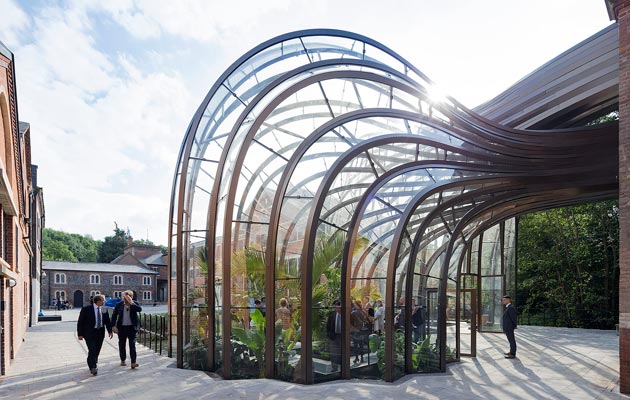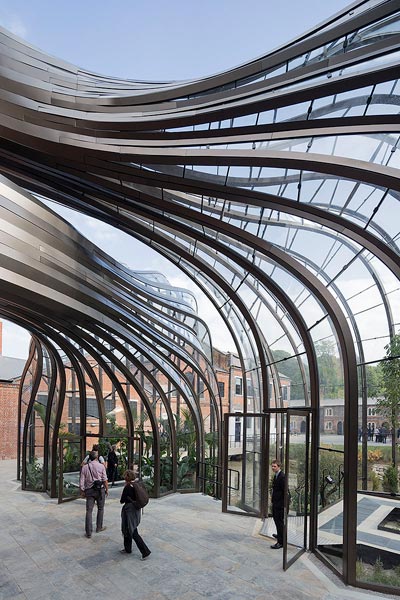|
|
||
|
The designer’s dramatic glasshouses for Bombay Sapphire’s new distillery in Hampshire resemble a Tim Burton-like fantasy of a factory Despite its trademark blue glass bottle, with its faux Victoriana and references to the Raj – and its claims to be made from a secret recipe harking back to 1761 – Bombay Sapphire gin was actually created in the late 1980s by US marketing guru Michel Roux. The company’s new distillation plant in Hampshire, designed by Thomas Heatherwick, resembles a Tim Burton-like fantasy of a factory. The sinuous lines of two glass structures can be made out over the industrial Victorian rooftops, the steam punk aesthetic hinting at a world of rich make-believe. Like the brand, the place is full of antique patinas and historical references, but at the same time seems absolutely fake. Laverstoke Mill, situated on the Test in rural Hampshire, was once the place where all the cloth paper for the Empire’s bank notes was made. Over the years, it had become a site cluttered with industrial buildings. “You could have been in the middle of Hoxton,” Heatherwick says, “all these industrial buildings and dead ends everywhere – no sense that you were in the English countryside.” Heatherwick has successfully stripped out these “barnacles”, to foreground the chalk stream that runs through the centre of the site and had been built over in places. One enters the facility by walking along this verdurous waterfront; the company’s logo, a medallion featuring Queen Victoria, is carved into the brick facade.
The restoration is sensitive, removing layers of over-building and additions, while deliberately leaving their ghostly traces in the brickwork and masonry. Gigantic copper pot stills, with elegant swan necks, are housed in gutted, hangar-like industrial spaces. (Heatherwick explains that these inspired his use of copper for the 2012 Olympic cauldron.) The gin is distilled using this alchemical-looking equipment and is flavoured using a special vapour infusion process, with ten Mediterranean and tropical herbs: aniseed, liquorice, grains of paradise, coriander, cassia bark, bitter almond, lemon peel, angelica root, cubeb and juniper berries. The site is intended as a visitor attraction as well as a factory and, at its heart, Heatherwick has been allowed a trademark flourish. He has widened the river to three times its original width to create an island where two glasshouses sprout as if straight from the water.
“The architecture of glasshouses seems to have ossified,” Heatherwick enthuses, with reference to Crystal Palace, “and they’ve lost some of their beauty, dynamism and joy.” His dramatic centrepiece, which is star-shaped in plan, is apparently made of 793 unique pieces of glass, held in place by a stainless steel structure with bronzed aluminium mullions, featuring 10,000 bespoke components. Here, samples of the gin’s ten exotic ingredients are warmed using the excess heat from the distillation process. The hothouses, with their dramatic lines and pleats, form an undeniably arresting backdrop for visitor photos. However, despite their educational intent and umbilical connection to the factory, through which the air is drawn back into the still house, there is something rather pointless seeming about Heatherwick’s swooshing, grand gesture. One is reminded of the laboratory used to extract sunbeams from cucumbers in Gulliver’s Travels, which were – like gin – “to be put in phials hermetically sealed, and let out to warm the air in raw inclement summers.” |
Words Christopher Turner |
|
|
||





















